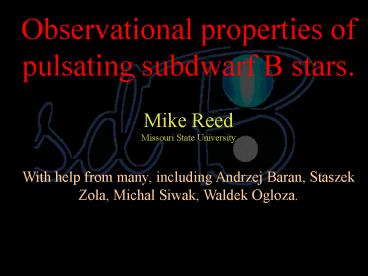Observational properties of pulsating subdwarf B stars. PowerPoint PPT Presentation
Title: Observational properties of pulsating subdwarf B stars.
1
Observational properties of pulsating subdwarf B
stars. Mike Reed Missouri State University With
help from many, including Andrzej Baran, Staszek
Zola, Michal Siwak, Waldek Ogloza.
2
Views of 3 pulsating sdB stars Each with
different properties. We wish to understand them
and determine how they resemble other pulsating
sdB stars.
3
Connecting to a larger picture What can we learn
using Asteroseismology? Stellar evolutionary
timescales Cosmochronology Stratifying of
stellar interiors Stellar crystallization
Nuclear fusion cross sections Masses, radii,
and luminosities of stars (distance scales and
population synthesis) Diffusive processes
Convection Neutrinos Elementary particle
physics Helium flash radiative levitation
binary evolution Type I supernovae Mass
exchange and loss Stellar magnetism
Interstellar enrichment Electroweak theory
Core/Envelope ratios semiconvection Stellar
equations of state Stellar winds Lollypop to
Popsicle ratio.
4
(No Transcript)
5
A Radial Pulsator l0 The entire surface changes.
6
A Nonradial Pulsator l1 1 line across the
surface.
7
A Nonradial Pulsator l2 2 lines across the
surface.
8
But when many are combined.... It is hard to
distinguish the mode.
9
First Goal Determine the spherical harmonics of
pulsation frequencies to constrain models.
10
Mode Identification Methods Traditional
Frequencies and spacings Feige 48 Binary
interactions PG1336-018
11
(No Transcript)
12
Feige 48 Observed over several years and from
multiple campaigns.
13
Triplet
14
(No Transcript)
15
Our Model Solution Total Mass 0.4725
Msolar Shell Mass 0.0025 Msolar Teff29635 K
(29,500/-500) log g 5.518 (5.50/-0.05) Near
core He exhaustion (0.74 by mass) Predicted a
rotation period near 0.4 days, which was detected
the following year.
16
Binary sdB pulsator
PG1336-018 Observed by WET in 1999 and 2001
17
Binary Period is 2.4 HoursThe companion (M5V)
contributes little light to the integrated flux.
i81o
18
PG1336-018Over 20 Pulsation Frequencies Detected
within 2500 mHz
- 2.4 hour orbital period.
- Tidal forces are comparable to Coriolis force
19
Effects to look for.
- Eclipse Mapping
- Tidal Influence on Pulsations
20
Eclipse Mapping
21
l1, m1
22
(No Transcript)
23
PG1336-018 An ideal case! 15 minute eclipses
covering 60 of the pulsator.
24
Eclipse data for PG1336
- All the in-eclipse modes are new! (Except for 2.)
- But not where we expect them to be from
splittings seen in the OoE data. - Most modes are splittings away from OoE modes.
Results PG1336 eclipses do not map pulsations as
we expect.
25
Tipped Pulsation Axis(Tidal Influence on
Pulsations)
26
A tipped pulsation axis?
- Tidal forces exceed Coriolis force.
- Pulsation axis will point at companion- similar
to roAp stars. - Orbital motion will precess the pulsation axis,
completing one revolution every couple hours.
27
l2, m1
28
(No Transcript)
29
(No Transcript)
30
Each tipped pulsation mode has 3 signatures.
- Number and separation of peaks in the combined FT
- Predictable regions of like phase.
- If divided into regions of like phase, a central
peak should show up.
31
(No Transcript)
32
And what did we really see?
33
(No Transcript)
34
(No Transcript)
35
Nothing new and/or exciting.
36
(No Transcript)
37
Here is one!
38
(No Transcript)
39
What have we learned? 1 good and 1 mediocre l1,
m1 identifications. 1 reasonable l2, m0
identification. 1 reasonable l2, m1
identification. On to the models for PG1336!
40
PG0048 An unexpected surprise!
41
Every night, something new!
42
(No Transcript)
43
Detected a total of 29 frequencies. But only 1
of them is detected in every good-quality run.
44
(No Transcript)
45
(No Transcript)
46
Signatures of stochastic oscillations Highly
variable amplitudes. Sometimes (or often) damped
below detectability Combinations of data have
reduced amplitudes (because of phase differences)
47
Simulations of stochastic oscillations
48
Best fit results for PG0048 A damping timescale
if 4 6 hours and a re-excitation timescale of
13 19 hours.
49
Results Feige 48 solved using traditional
methods. PG1336 shows indications of inclined
pulsation axis which can constrain
models. PG0048 shows indications of stochastic
oscillations.

